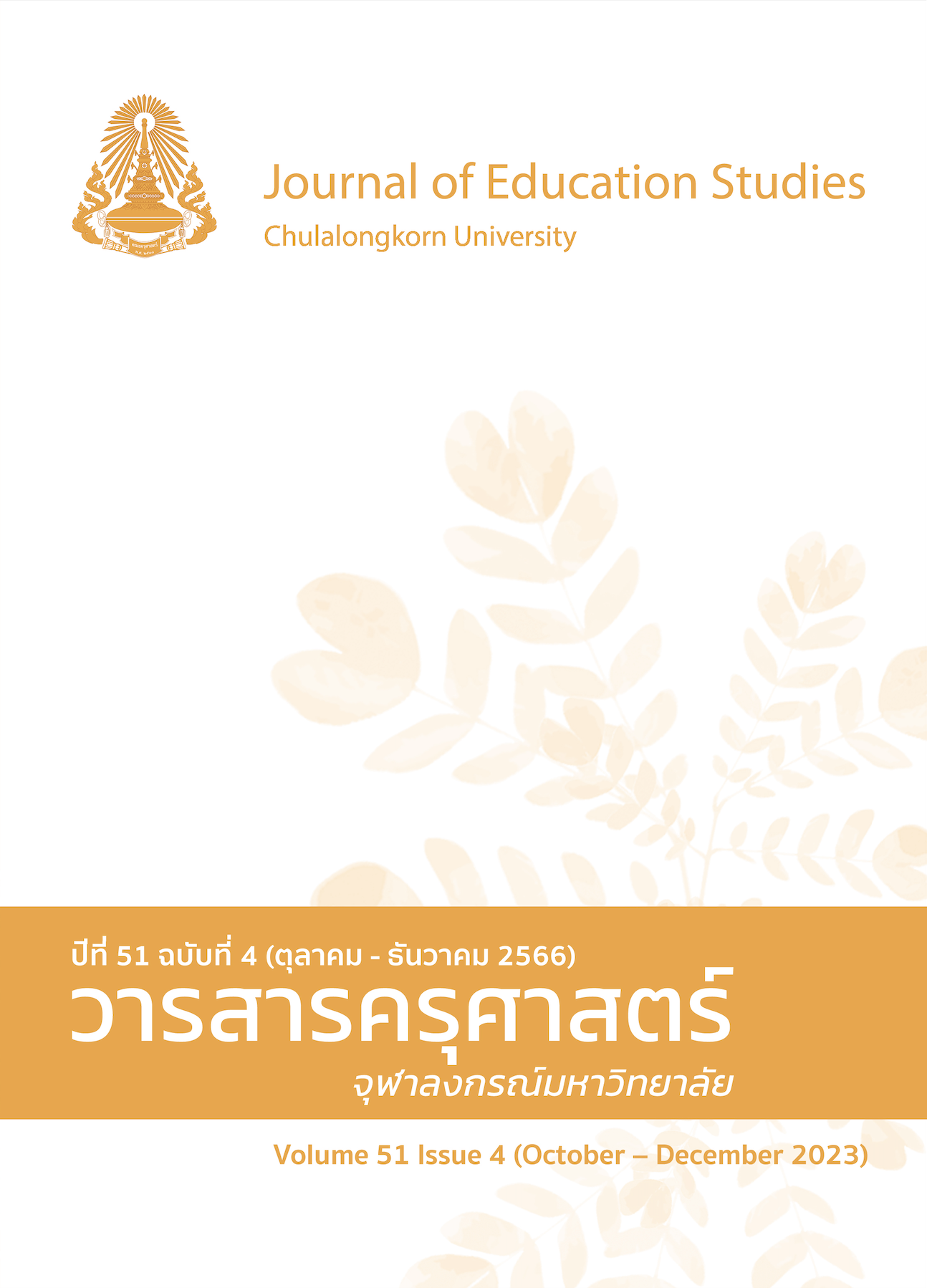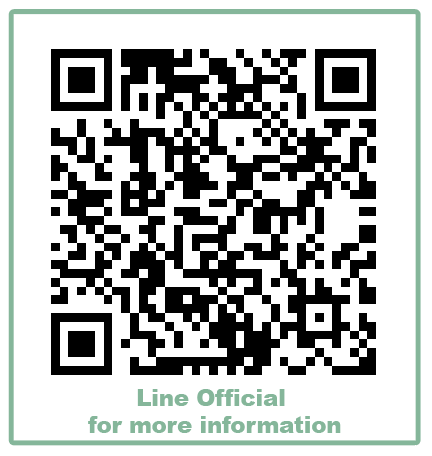การพัฒนาและตรวจสอบความตรงของโมเดลปัจจัยที่ส่งผลต่อทักษะแห่งอนาคตที่จำเป็นของผู้ใหญ่สูงวัย
DOI:
https://doi.org/10.14456/educu.2023.38คำสำคัญ:
ทักษะแห่งอนาคต, การจัดการเรียนรู้แบบยืดหยุ่น, สภาพแวดล้อมการเรียนรู้, การประเมินการเรียนรู้, ผู้ใหญ่สูงวัยบทคัดย่อ
ประเทศไทยกำลังจะก้าวเข้าสู่สังคมสูงอายุแบบขั้นสูงสุด จึงควรเตรียมการพัฒนาทักษะที่จำเป็นของผู้ใหญ่สูงวัยให้สามารถทำงานได้อย่างมีคุณภาพ การวิจัยนี้จึงพัฒนาและตรวจสอบความสอดคล้องของโมเดลปัจจัยที่ส่งผลต่อทักษะแห่งอนาคตที่จำเป็นของผู้ใหญ่สูงวัยกับข้อมูลเชิงประจักษ์ พร้อมทั้งวิเคราะห์อิทธิพลของการจัดการเรียนรู้แบบยืดหยุ่น การจัดสภาพแวดล้อมการเรียนรู้ และการประเมินการเรียนรู้ที่มีต่อทักษะแห่งอนาคตที่จำเป็นของผู้ใหญ่สูงวัย ผลการตรวจสอบความสอดคล้องของโมเดลปัจจัยที่ส่งผลต่อทักษะแห่งอนาคตที่จำเป็นของผู้ใหญ่สูงวัยกับข้อมูลเชิงประจักษ์ พบว่าโมเดลที่พัฒนาขึ้นมีความสอดคล้องกับข้อมูลเชิงประจักษ์ ((121,N = 120) = 136.62, p = .16,
/df = 1.13, CFI = 0.99, TLI = 0.99, RMSEA = 0.03,
SRMR = 0.03) โดยการจัดการเรียนรู้แบบยืดหยุ่น (β = 0.31) มีอิทธิพลต่อทักษะแห่งอนาคตที่จำเป็นของผู้ใหญ่สูงวัยสูงที่สุด รองลงมา คือ การจัดสภาพแวดล้อมการเรียนรู้ (β = 0.21) และการประเมินการเรียนรู้ (β = 0.15) ตามลำดับ
References
ภาษาไทย
ใจทิพย์ ณ สงขลา และ ศิริเดช สุชีวะ. (2566). กรอบทักษะแห่งอนาคตของประชากรไทยทุกช่วงวัยเพื่อการพัฒนาอย่างยั่งยืน. วารสารมหาวิทยาลัยศิลปากร, 43(5).
วิชช์ เกษมทรัพย์. (2564, 25 กรกฎาคม). เราเตรียมพร้อมกันหรือยังกับการดูแลผู้สูงวัยอย่างมีคุณภาพและครอบคลุม. Post Today. https://www.posttoday.com/politic/columnist/658911
สราวุธ ไพฑูรย์พงษ์. (2560, 20 มกราคม). ระบบการจ้างงานผู้สูงอายุของญี่ปุ่น. สถาบันวิจัยเพื่อการพัฒนาประเทศไทย. https://tdri.or.th/2017/ 01/2017-01-20/
ภาษาอังกฤษ
Ahmad, N. A., & Chua, L. N. (2015). Technology and higher education: Using an e-learning tutorial as a pedagogy for innovation and flexible learning. Malaysian Journal of Distance Education,
(1), 21-31.
Alsalhi, N. R., Eltahir, M. E., & Al-Qatawneh, S. S. (2019). The effect of blended learning on the achievement of ninth grade students in science and their attitudes towards its use. Heliyon, 5(9), e02424. https://doi.org/10.1016/j.heliyon.2019.e02424
Andrade, M. S., & Alden-Rivers, B. (2019). Developing a framework for sustainable growth of flexible learning opportunities. Higher Education Pedagogies, 4(1), 1-16. https://doi.org/ 10.1080/
2018.1564879
Brand-Gruwel, S., Kester, L., Kicken, W., & Kirschner, P. A. (2014). Learning ability development in flexible learning environments. In J. M. Spector, M. D. Merrill, J. Elen, & M. J. Bishop (Eds.), Handbook of research on educational communications and technology (pp. 363-372). New York.
Bryant, K., Campbell, J., & Kerr, D. (2003). Impact of web based flexible learning on academic performance in information systems. Journal of Information Systems Education, 14(1), 41-50.
China Today. (2019). Top 10 emerging skills in China’s job market. China Today, 68(2), 8.
Collis, B., & Moonen, J. (2002). Flexible learning in a digital world. Open Learning: The Journal of Open, Distance and e-Learning, 17(3), 217-230. https://doi.org/10.1080/ 0268051022000048228
Cook, S., Watson, D., & Vogues, D. (2019). Solving the quantitative skills gap: A flexible learning call to arms!. Higher Education Pedagogies, 4(1), 17-31. https://doi.org/ 10.1080/ 23752696.2018.1564880
Dikli, S. (2003). Assessment at a distance: Traditional vs. alternative assessments. Turkish Online Journal of Educational Technology, 2(3), 13-19.
Dondi, M., Klier, L., Panier, F., & Schubert, J. (2021, June 25). Defining the skills citizens will need in the future world of work. McKinsey and Company. https://www.mckinsey. com/industries/
public-and-social-sector/our-insights/defining-the-skills-citizens-will-need-in-the-future-world-of-work#
Geduld, B. (2014). Self-directedness in open distance learning: Twists and turns. International Journal of Instructional Technology and Distance Learning, 11(9), 23-36.
Harahap, F., Nasution, N. E. A., & Manurung, B. (2019). The effect of blended learning on student's learning achievement and science process skills in plant tissue culture course. International Journal of Instruction, 12(1), 521-538. https://doi.org/10.29333/ iji.2019.12134a
Haryati, H. (2018). Investigating the effect of blended learning on students’ grammar achievement. Jurnal Ilmiah Humanika, 1(1), 58-64.
Jones, B., & Walters, S. (2015). Flexible learning and teaching: Looking beyond the binary of full-time/part-time provision in South African higher education. Critical Studies in Teaching and Learning, 3(1), 61-84. https://doi.org/10.14426/cristal.v3i1.29
Kline, R. B. (2016). Principles and practice of structural equation modeling (4th ed.). Guilford publications.
Mutch, C. (2012). Assessment for, of and as learning: Developing a sustainable assessment culture in New Zealand schools. Policy Futures in Education, 10(4), 374-385. http:// dx.doi.org/10.2304/pfie.2012.10.4.374
Nazir, M. J., Rizvi, A. H., & Pujeri, R. V. (2012). Skill development in multimedia based learning environment in higher education: An operational model. International Journal of Information and Communication Technology Research, 2(11), 820-828.
Nissim, Y., Weissblueth, E., Scott-Webber, L., & Amar, S. (2016). The effect of a stimulating learning environment on pre-service teachers' motivation and 21st century skills. Journal of Education and Learning, 5(3), 29-39. http://dx.doi.org/10.5539/jel. v5n3p29
Olele, C. N. (2012). Alternative assessment: Emerging trends of classroom assessment in digital era. Academic Research International, 3(1), 42-49.
Oliver, R., & Herrington, J. (2001). Teaching and learning online: A beginner's guide to e-learning and e-teaching in higher education. Centre for Research in Information Technology and Communications, Edith Cowan University.
Oyinloye, O. M., & Imenda, S. N. (2019). The impact of assessment for learning on learner performance in life science. Eurasia Journal of Mathematics, Science and Technology Education, 15(11), em1775. https://doi.org/10.29333/ejmste/108689
Requena-Carrión, J., Alonso-Atienza, F., Guerrero-Curieses, A., & Rodríguez-González, A. B. (2010, April
-16). A student-centered collaborative learning environment for developing communication skills in engineering education [Paper presentation]. IEEE EDUCON 2010 Conference, Spain.
Rodriguez, M. C. (2004). The role of classroom assessment in student performance on TIMSS. Applied Measurement in Education, 17(1), 1-24. https://doi.org/10.1207/s153 24818ame1701_1
Schellekens, L. H., Bok, H. G., de Jong, L. H., van der Schaaf, M. F., Kremer, W. D., & van der Vleuten, C. P. (2021). A scoping review on the notions of assessment as learning (AaL), assessment for learning (AfL), and assessment of learning (AoL). Studies in Educational Evaluation, 71, 101094. https://doi.org/10.1016/j.stueduc.2021.101094
Singapore Legal Advice. (2022, July 1). Guide to re-employment and retirement in Singapore. https://singaporelegaladvice.com/law-articles/re-employment-retirement-singapore
Soper, D. S. (2022). A-priori sample size calculator for structural equation models. Free Statistics Calculators. http://www.danielsoper.com/statcalc
Strampel, K., & Oliver, R. (2007). Using technology to foster reflection in higher education [Paper presentation]. Proceedings Ascilite Singapore, Singapore.
Ujikane, K., & Schneider, J. (2016, July 12). Japanese may soon need to work until 80 as population ages. Independent. https://www.independent.co.uk/news/business/news/ japanese-work-until-80-ageing-population-pensions-a7132331.html
Umar, A. T., & Majeed, A. (2018). The impact of assessment for learning on students' achievement in English for specific purposes: A case study of pre-medical students at Khartoum University: Sudan. English Language Teaching, 11(2), 15-25. http://doi.org/ 10.5539/elt.v11n2p15
Valtonen, T., Leppänen, U., Hyypiä, M., Kokko, A., Manninen, J., Vartiainen, H., Sointu, E., & Hirsto, L. (2021). Learning environments preferred by university students: A shift toward informal and flexible learning environments. Learning Environments Research, 24(3), 371-388. https://doi.org/10.1007/s10984-020-09339-6
Weston, R., & Gore Jr, P. A. (2006). A brief guide to structural equation modeling. The Counseling Psychologist, 34(5), 719-751. https://doi.org/10.1177/0011000006286345
Yeen-Ju, H. T., Mai, N., & Selvaretnam, B. (2015). Enhancing problem-solving skills in an authentic blended learning environment: A Malaysian context. International Journal of Information and Education Technology, 5(11), 841-846. https://doi.org/10.7763/ IJIET. 2015.V5.623
Zhao, D., McCoy, A. P., Bulbul, T., Fiori, C., & Nikkhoo, P. (2015). Building collaborative construction skills through BIM-integrated learning environment. International Journal of Construction Education and Research, 11(2), 97-120. https://doi.org/10.1080/155787 71.2014.986251
Downloads
เผยแพร่แล้ว
How to Cite
ฉบับ
บท
License

This work is licensed under a Creative Commons Attribution-NonCommercial-NoDerivatives 4.0 International License.



